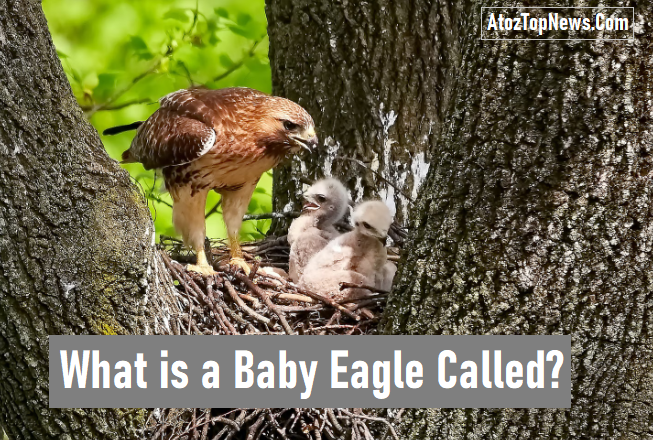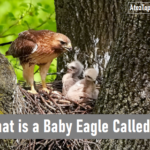Today we will discuss in this post what is a baby eagle called? A Baby Eagle is an extraordinary bird. It is a close relative of the Northern Flicker, but it can fly and stay airborne for a long time, unlike its cousin. A baby eagle is a bird of prey, often with a long tail and tiny wings.
Baby Eagle is a species of bird native to North America. They have white feathers, and their wings are covered in black feathers. . They are large birds, with the most significant weighing up to 40 pounds. Adults have a face mask, and their beak is orange. Eagle owls have been kept as pets for centuries.
What is a Baby Eagle Called?
An eagle’s nest is a huge and majestic nest. Its eyes are on the sides of the bird’s head. What is a Baby Eagle Called? is its baby’s first and most important task. It will grow into a fully grown adult eagle after it’s been fed for about four months. Its name is “eaglet,” but it can be referred to as a chick, eaglet, or fledgling.
A hawk’s baby is called an eaglet. Its parents are called eaglets. They remain with their parents for 35 days before they are ready to fly. A hawk’s eggs are about two centimeters in diameter and weigh about three ounces. The eaglet’s legs and wings are covered in grey downy feathers.
What You Need To Know About The Baby Eagle?
The eaglet develops a ‘hatching muscle’ before it leaves the egg. This ‘hatching muscle’ is the sharp point on the beak. When the eaglet gets large enough, it contacts the inside surface of the egg. At this stage, it flies away and begins the process of survival, feeding, and procreation. As the eaglet grows, it will mimic the behavior of its parents to learn to fly.
The first sign that an eaglet is ready to leave its nest is that its head is poking above the rim. The parents are usually away from their nest, perching in nearby trees. The eaglets are fed directly by the adults for the first five weeks of their life, but by five or six weeks, they can feed themselves. The parents usually bring the same amount of food to the nest, which is called brooding.
How Many Species Of Eagles Are There?
The world has about 500 species of birds. However, there are only about 30 species of eagles. This means that about 30% of the world’s birds are unknown to science. . It is estimated that there are more than 10,000 species of birds and about 600,000 species of fish in the world’s oceans.
The eaglet’s name refers to both the female and male members of the species. The male eagles mate for life. The females typically begin courtship between four and five years of age, and the eaglets leave their nest at about 10 to 12 weeks of age. They are called ‘fledglings’ and learn from their parents for one to two months.
What Does a Baby Eagle Look Like?
The baby eagle is the national bird of Canada and is an iconic symbol of the country. The baby eagle can be seen in many places around the world, including on Canadian currency.
The parents protect their chicks from extreme temperatures. During the first three weeks, the female may leave the nest briefly to feed other birds. The male replaces her immediately. During the fifth and sixth weeks, the parents are more relaxed and spend longer periods away from the nest.
By the sixth week, the male and female parents start to roost away from the nest and eat separately. The eaglet is able to maintain its body temperature without the help of brooding.
An eagle’s beak is hooked. The baby eagle’s beak is similar to that of a chicken. The beak features a hook in the middle and a hooked comb. The beak is also shaped like an egg. The young eagle fledges after about 10 to 14 weeks. Despite being a little different from other birds, they will look very similar to each other.
How Big is a Baby Eagle Called?

A baby eagle is a small bird with a wingspan of about 4 inches. It is the smallest member of the genus Accipiter, which also includes hawks, eagles and kites. . They are found in the temperate and tropical regions of the globe. According to the IUCN, there are two subspecies. The nominate subspecies is “A. a. arielus”, while another is “A. a. capensis”.
How Much Do Baby Eagles Weigh?
The bird’s weight varies from individual to individual. This section is about the number of baby eagles that are born in the world, and their weight. The weight of an eagle is dependent upon the health and age of that bird, as well as the quality of the food it eats.
Eagles are also dependent upon the weather in their area. In general, a large eagles will weigh more than a small eagles (with an average weight being around 2 to 4 kg). Eggs are laid by the female bird, and are placed inside the nest of a nest building.
The egg takes about three weeks to hatch, and the young birds will be full grown after about nine to eleven weeks. A baby brown eagle will usually have an average weight of 2 – 4 kg.
What Do Baby Eagles Eat?
Raw meat is given to baby eagles from day one. Their parents do not eat the food they prepare but instead cut it into small pieces and give it to their chicks. In the beginning, the father will hunt and feed the chicks. However, the mother will join the fray after a few weeks or when food is scarce.
Baby eagles are born and immediately start to eat their parents’ solid food immediately. The father usually provides most of the first meals. This is because eagles can eat any meat or small animal they find. They aren’t picky because they are opportunistic.
Mother Eagles care about their baby’s safety.
Did you know that female eagles are very serious about the safety of their young? It’s true! It’s true! Baby eagles are born high above the ground in a nest. Usually, two or three eggs are being laid at once.
The mother eagle will lay her eggs before the nest is built. Sometimes, even before the nest is built. As building materials, they use sticks, feathers and dried grass.
A nest of eagles is approximately four to five feet in size. A pair of eagles may return to the same nesting site to lay new eggs, and Eagles often build a new nest over the existing one. Nests can reach up to twenty feet in size.
Baby Bald Eagles are Born Grey.
Most people think of a baby bald eagle because of its distinctive white head and brown body, and these babies don’t have this colouration.
After a bald eagle hatches, it will turn a light grey colour for several weeks, and they will then turn brown throughout their bodies. A baby bald eagle will no longer be a baby when it has its famous brown and white feathers. These feathers can ultimately take as long as five years to arrive, and bald eagles can reach six feet in length.
What do you call a baby eagle?
A typical baby eagle looks like a chicken but is a raptor. It was believed that the long-legged, long-winged bird looked like a chicken. Recently, scientists have discovered that the “chicken-looking” bird was an eagle.
A baby eagle is a tiny bird. It is the smallest member of the genus Accipiter. It is known for its long, narrow wings and long legs, adapted for soaring. It has a long, narrow head and tiny, rounded wings. Its legs are short, but they have large claws which help it find food.
Eggs: The eggs of a baby eagle are tiny and hard to see in the nest because they resemble those of a frog despite being very similar in shape. The mother lays the eggs close together in a hollow tree or branch. They hatch after about two weeks and are covered in fine feathers which will not be damaged by the weather anymore during their growth. Young birds grow very fast, up to almost 20 cm (7 inches) in one month.
Gender: The male has a long tail that he uses for fighting with other males and defending his territory. The female remains in the nest with her chicks and feeds them. In some female eagles, the male is not present in the nest and thus lays eggs alone. The parental care of young birds is provided by both parents, who are always together. (Male eagles usually leave their offspring when they are 5 to 6 months old.)

It is really a nice and useful piece of information. I¦m happy that you shared this useful information with us. Please keep us up to date like this. Thanks for sharing.